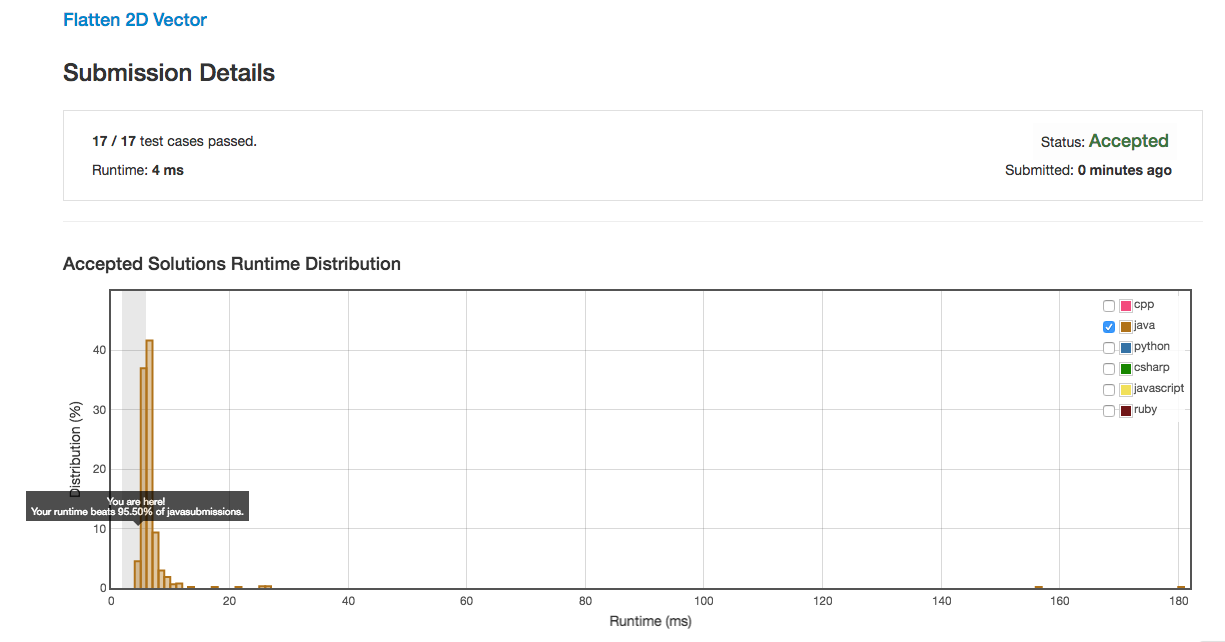251. Flatten 2D Vector
题目:
Implement an iterator to flatten a 2d vector.
For example,
Given 2d vector =
[ [1,2], [3], [4,5,6] ]
By calling next repeatedly until hasNext returns false, the order of elements returned by next should be: [1,2,3,4,5,6].
Hint:
- How many variables do you need to keep track?
- Two variables is all you need. Try with
xandy. - Beware of empty rows. It could be the first few rows.
- To write correct code, think about the invariant to maintain. What is it?
- The invariant is
xandymust always point to a valid point in the 2d vector. Should you maintain your invariant ahead of time or right when you need it? - Not sure? Think about how you would implement
hasNext(). Which is more complex? - Common logic in two different places should be refactored into a common method.
Follow up:
As an added challenge, try to code it using only iterators in C++ or iterators in Java.
链接: http://leetcode.com/problems/flatten-2d-vector/
题解:
构造一个2D的iterator。不太理解iterator的原理,第一想法是把vec2d里面的元素都读到Queue里 ,然后再逐个读取。这样的话初始化需要O(n), next和hasNext都为O(1),Space Complexity也是O(n),虽然能ac,但是当vec2d足够大的时候会出问题。
Time Complexity - constructor - O(n), hasNext - O(1), next() - O(1), Space Complexity - O(n)。
public class Vector2D { private Queue<Integer> vec1d; public Vector2D(List<List<Integer>> vec2d) { vec1d = new LinkedList<>(); for(List<Integer> list : vec2d) { for(int i : list) { vec1d.offer(i); } } } public int next() { if(hasNext()) return vec1d.poll(); else return Integer.MAX_VALUE; } public boolean hasNext() { return vec1d.size() > 0; } } /** * Your Vector2D object will be instantiated and called as such: * Vector2D i = new Vector2D(vec2d); * while (i.hasNext()) v[f()] = i.next(); */
Update: 保存两个变量来遍历vec2d
public class Vector2D { private List<List<Integer>> list; private int listIndex; private int elemIndex; public Vector2D(List<List<Integer>> vec2d) { list = vec2d; listIndex = 0; elemIndex = 0; } public int next() { return list.get(listIndex).get(elemIndex++); } public boolean hasNext() { while(listIndex < list.size()) { if(elemIndex < list.get(listIndex).size()) { return true; } else { listIndex++; elemIndex = 0; } } return false; } } /** * Your Vector2D object will be instantiated and called as such: * Vector2D i = new Vector2D(vec2d); * while (i.hasNext()) v[f()] = i.next(); */
二刷:
使用了ArrayList的iterator,这个算不算作弊...思路就是,一开始把vec2d里面每个list的iterator都加入到一个iters的ArrayList里。之后就可以很简单地写好hasNext()和next()两个方法了。
Java:
public class Vector2D implements Iterator<Integer> { private List<Iterator<Integer>> iters; private int curLine = 0; public Vector2D(List<List<Integer>> vec2d) { this.iters = new ArrayList<>(); for (List<Integer> list : vec2d) { iters.add(list.iterator()); } } @Override public Integer next() { return iters.get(curLine).next(); } @Override public boolean hasNext() { while (curLine < iters.size()) { if (iters.get(curLine).hasNext()) return true; else curLine++; } return false; } } /** * Your Vector2D object will be instantiated and called as such: * Vector2D i = new Vector2D(vec2d); * while (i.hasNext()) v[f()] = i.next(); */
Update:
还是使用两个元素来遍历
public class Vector2D implements Iterator<Integer> { private List<List<Integer>> list; private int curLine = 0; private int curElem = 0; public Vector2D(List<List<Integer>> vec2d) { this.list = vec2d; } @Override public Integer next() { return list.get(curLine).get(curElem++); } @Override public boolean hasNext() { while (curLine < list.size()) { if (curElem < list.get(curLine).size()) { return true; } else { curLine++; curElem = 0; } } return false; } } /** * Your Vector2D object will be instantiated and called as such: * Vector2D i = new Vector2D(vec2d); * while (i.hasNext()) v[f()] = i.next(); */

Reference:
http://web.cse.ohio-state.edu/software/2231/web-sw2/extras/slides/17a.Iterators.pdf
http://docs.oracle.com/javase/7/docs/api/
http://stackoverflow.com/questions/21988341/how-to-iterate-through-two-dimensional-arraylist-using-iterator
http://www.cs.cornell.edu/courses/cs211/2005fa/Lectures/L15-Iterators%20&%20Inner%20Classes/L15cs211fa05.pdf
https://leetcode.com/discuss/50292/7-9-lines-added-java-and-c-o-1-space
https://leetcode.com/discuss/55199/pure-iterator-solution-additional-data-structure-list-get
https://leetcode.com/discuss/57984/simple-and-short-java-solution-with-iterator
https://leetcode.com/discuss/50356/my-concise-java-solution
https://leetcode.com/discuss/68860/java-o-1-space-solution
https://leetcode.com/discuss/71002/java-solution-beats-60-10%25




